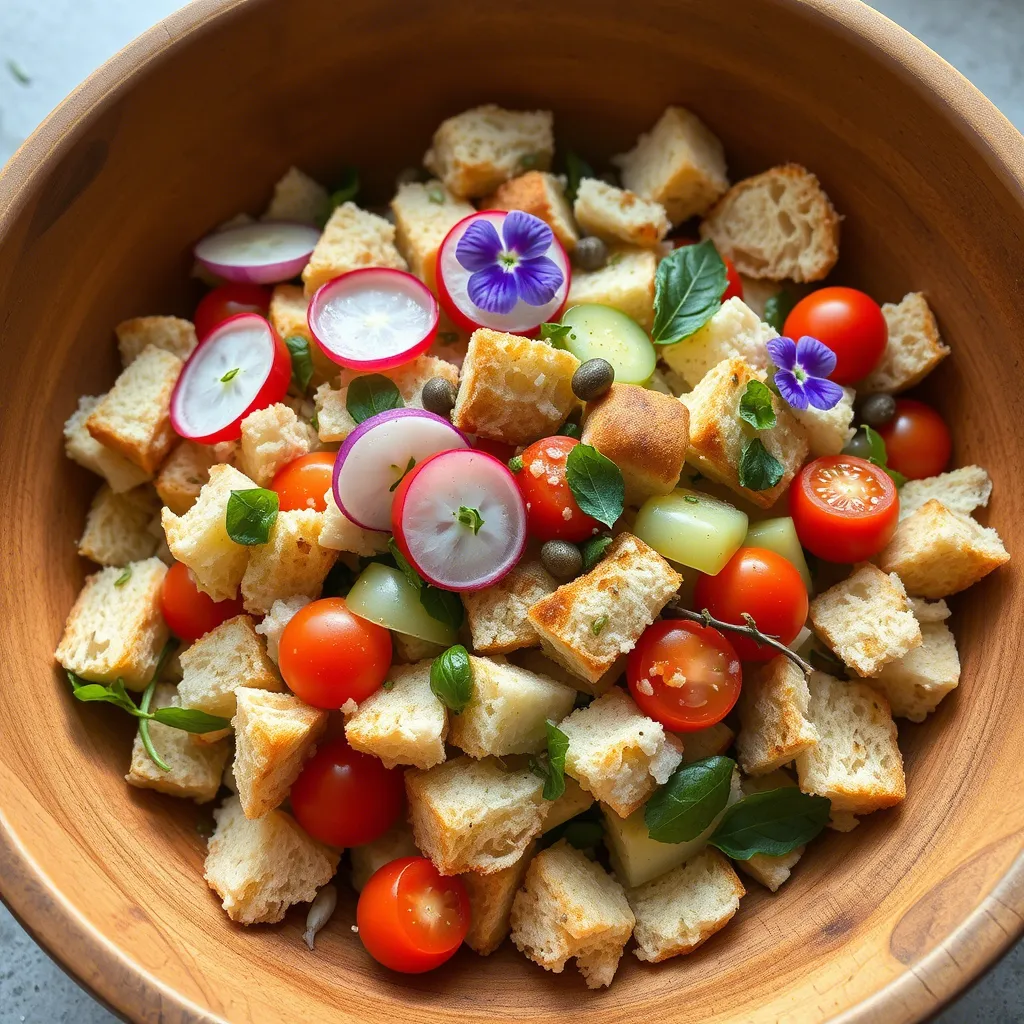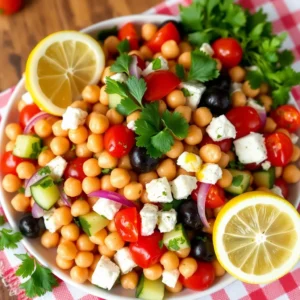Why You’ll Love This Spring Panzanella Salad
There’s something magical about spring that makes me want to throw open the windows, breathe in the fresh air, and fill my kitchen with the vibrant colors of seasonal produce. This Spring Panzanella Salad with Herbs is exactly the recipe you need to celebrate the season’s bounty while keeping mealtime simple and delicious.
Picture this: chunks of crusty bread soaking up a bright, herby dressing while mingling with crisp spring vegetables and fresh herbs. It’s the kind of dish that makes you feel like you’re dining al fresco in an Italian countryside, even if you’re just at your kitchen table on a Wednesday night.
For all my busy moms out there juggling soccer practice, work meetings, and the eternal question of “what’s for dinner?”, this panzanella salad is about to become your new best friend. It takes just 20 minutes of prep time and requires minimal cooking – perfect for those evenings when turning on the oven feels like one task too many.
What I absolutely adore about this spring panzanella is its versatility. Need to use up that slightly stale artisan loaf before it turns into a brick? This salad is the answer. Have some asparagus, radishes, or peas that are about to go past their prime? Toss them in! It’s the ultimate “clean out the produce drawer” recipe that somehow always looks and tastes like you planned it all along.
The beauty of panzanella is that it’s hearty enough to be a complete meal, especially when you add a protein like grilled chicken or white beans for a vegetarian option. But it also makes a stunning side dish for a weekend gathering. I’ve brought this to countless spring potlucks and always return home with an empty bowl and requests for the recipe.
If you’re trying to incorporate more vegetables into your family’s diet (aren’t we all?), this salad is a sneaky way to make raw veggies irresistible. Even my vegetable-suspicious nephew couldn’t resist the combination of crunchy cucumbers, sweet tomatoes, and bread that had soaked up all those amazing flavors.
Another reason to love this recipe? It actually tastes better after it sits for a bit, making it ideal for meal prep or making ahead for a gathering. Unlike most salads that wilt into sad, soggy messes, this one develops more flavor as the ingredients mingle, making it perfect for busy households.
The Story Behind This Spring Panzanella Salad
My love affair with panzanella began during a spring vacation in Tuscany years ago. I was staying at a small agriturismo where the owner, Signora Martelli, prepared the most incredible meals using whatever was fresh from her garden that morning. One particularly sunny afternoon, she served a simple bread salad that changed the way I thought about “using up” stale bread forever.
“Niente spreco,” she told me – “nothing wasted.” It was a philosophy that guided her entire approach to cooking and one that resonated deeply with me. In her kitchen, day-old bread wasn’t a disappointment; it was an opportunity to create something new and wonderful.
When I returned home, I was determined to recreate that magical Tuscan experience. But as I experimented, I found myself adapting the traditional panzanella to celebrate the beautiful spring produce we get here in America. The classic tomato-based summer panzanella is delightful, but this spring version with tender asparagus, radishes, and fresh herbs has become my personal favorite.
My kids, who initially wrinkled their noses at what essentially looked like “wet bread” to them, now request this salad weekly during spring. I think it’s the combination of different textures – the crunch of vegetables, the chew of the bread, and the burst of fresh herbs – that won them over. Plus, there’s something irresistibly fun about eating bread in a salad that makes even picky eaters willing to give it a try.
Every time I make this Spring Panzanella Salad, I’m transported back to that Tuscan kitchen, with sunlight streaming through the windows and the scent of herbs filling the air. It’s a reminder that sometimes the simplest dishes, born from necessity and resourcefulness, become the ones we treasure most.
This salad has saved me on countless busy weeknights when I needed something substantial but didn’t have the energy for an elaborate meal. It’s accompanied us on picnics, starred at Easter brunches, and even made appearances at office potlucks where colleagues have hunted me down for the recipe.
What I love most about sharing this recipe is how it connects us to centuries of Italian culinary wisdom. Long before “sustainability” was a buzzword, Italian cooks were finding delicious ways to use every scrap in their kitchens. This chicken cobb salad recipe shares that same resourceful spirit – transforming simple ingredients into something greater than the sum of its parts.
Over the years, I’ve tweaked and personalized this spring panzanella, sometimes adding goat cheese for creaminess or a handful of toasted nuts for extra crunch. That’s the beauty of recipes that come from tradition – they give us a foundation to build upon while honoring the wisdom of those who cooked before us.
So as you make this salad your own, I hope it brings a bit of that Tuscan sunshine into your kitchen, no matter where you are or how hectic your day has been. After all, food isn’t just about nourishment; it’s about creating moments of joy in our everyday lives – a philosophy I think Signora Martelli would wholeheartedly approve of.
Ingredients
Let’s talk about what makes this Spring Panzanella Salad so special – it’s all about fresh, vibrant ingredients that shine with minimal fuss. Here’s what you’ll need:
For the Bread Base:
- 1 loaf (about 8 cups) day-old crusty bread (sourdough, ciabatta, or a rustic country loaf)
- 3 tablespoons extra virgin olive oil
- 1 teaspoon salt
- Freshly ground black pepper
The bread is truly the foundation of any panzanella, and it’s worth being a bit picky here. You want something with substance – those airy, soft sandwich loaves will just turn to mush. A good crusty artisan bread with a decent chew is ideal, and slightly stale is actually perfect! If your bread is fresh, don’t worry – I’ll share a quick trick to dry it out in the execution section.
Remember that the bread will absorb all the amazing flavors in this salad, so choose something you’d enjoy eating on its own. My personal favorite is sourdough because it adds a subtle tanginess that plays wonderfully with the fresh spring vegetables.
For the Spring Vegetables:
- 1 bunch asparagus (about 1 pound), woody ends trimmed, cut into 2-inch pieces
- 1 cup fresh or frozen peas (thawed if frozen)
- 1 bunch radishes, thinly sliced
- 1 English cucumber, cut into 1/2-inch chunks
- 1 pint cherry or grape tomatoes, halved
- 3 green onions, thinly sliced
- 1 small fennel bulb, thinly sliced (optional, but adds wonderful crunch)
Spring produce is the star of this show! Asparagus brings that quintessential spring flavor – you can blanch it briefly or even use it raw if it’s very tender. The peas add sweet pops of flavor, while radishes bring a peppery crunch that cuts through the richness.
Cucumber and tomatoes might seem more summer-oriented, but good cherry tomatoes are available year-round now, and they add juicy bursts of flavor that help create that perfect bread-soaking dressing as the salad sits.
For the Herb Component:
- 1/2 cup mixed fresh herbs, roughly chopped (try a combination of basil, mint, parsley, chives, and dill)
- 1/4 cup fresh chives, snipped
Herbs are what transforms this from a regular panzanella into a spring celebration. Don’t skimp here – the more variety, the better! Each herb brings its own personality: basil adds sweetness, mint brings freshness, parsley adds brightness, and dill contributes a delicate anise flavor that pairs beautifully with the vegetables.
For the Dressing:
- 1/3 cup extra virgin olive oil (use the good stuff here!)
- 3 tablespoons white wine vinegar or lemon juice
- 1 tablespoon Dijon mustard
- 2 cloves garlic, finely minced or grated
- 1 teaspoon honey
- 1/2 teaspoon salt
- 1/4 teaspoon freshly ground black pepper
- Zest of 1 lemon
The dressing is simple but powerful. It’s a classic vinaigrette with a touch of Dijon for emulsification and honey for balance. The lemon zest adds a fragrant brightness that really amplifies the spring flavors in the salad.
Optional Add-ins (to make it heartier):
- 8 ounces fresh mozzarella pearls or burrata torn into pieces
- 1 can (15 oz) white beans, drained and rinsed
- 2 cups shredded rotisserie chicken
- 4 hard-boiled eggs, quartered
- 1/4 cup toasted pine nuts or sliced almonds
These additions can transform your spring panzanella from a side dish to a complete meal. The mozzarella adds wonderful creaminess, while beans or chicken make it more substantial. Hard-boiled eggs are a traditional addition in some panzanella variations and add richness, while nuts contribute welcome crunch and protein.
Execution
Now that we’ve assembled our cast of ingredients, let’s bring this Spring Panzanella Salad to life with some simple steps that allow each element to shine:
Step 1: Prepare the Bread
- Preheat your oven to 375°F (190°C).
- Cut or tear your bread into 1-inch chunks – irregular pieces create more interesting texture than perfect cubes.
- Toss the bread pieces on a baking sheet with the olive oil, salt, and a few grinds of black pepper, making sure each piece gets a light coating.
- Spread the bread in a single layer and bake for 10-12 minutes, tossing halfway through, until the edges are golden but the centers still have a bit of chew. We’re not making croutons here – we want bread that’s toasted enough to hold up to the dressing but will still soften pleasantly as it absorbs the flavors.
- Remove from the oven and let cool while you prepare the rest of the ingredients.
If you’re starting with fresh bread, this toasting step is essential – it creates the structure that allows the bread to absorb dressing without disintegrating into a soggy mess. If your bread is already quite stale, you might reduce the baking time slightly.
Step 2: Prepare the Spring Vegetables
- Bring a medium pot of salted water to a boil.
- Add the asparagus pieces and cook for just 1-2 minutes until bright green and crisp-tender.
- If using fresh peas, add them during the last 30 seconds.
- Quickly drain and immediately plunge into an ice water bath to stop the cooking and preserve that vibrant green color.
- Once chilled, drain well and pat dry with paper towels – excess water is the enemy of good panzanella!
The quick blanching preserves the asparagus’s texture while taking away any raw “grassiness.” If your asparagus is very thin and tender, you can skip the blanching and use it raw, thinly sliced on the diagonal.
Step 3: Make the Dressing
- In a small bowl or jar, combine the olive oil, vinegar or lemon juice, Dijon mustard, minced garlic, honey, salt, pepper, and lemon zest.
- Whisk vigorously until emulsified (or seal and shake the jar).
- Taste and adjust seasonings – the dressing should be punchy since it will be diluted once mixed with the other ingredients.
Don’t be tempted to use less dressing than called for – the bread needs to absorb it to achieve that perfect panzanella texture. According to this excellent guide from Serious Eats on the science behind panzanella, the perfect bread-to-dressing ratio is crucial for texture development.
Step 4: Assemble the Salad
- In a large bowl, combine the toasted bread, blanched asparagus and peas, sliced radishes, cucumber chunks, halved tomatoes, green onions, and fennel (if using).
- Pour about three-quarters of the dressing over the mixture and toss gently to combine.
- Let the salad sit for at least 10 minutes to allow the bread to start absorbing the dressing.
- Just before serving, add the chopped herbs and any optional protein add-ins.
- Drizzle with the remaining dressing, toss once more, and taste for seasoning, adding more salt and pepper if needed.
The magic of panzanella happens in that resting period when the bread soaks up the dressing and vegetable juices. However, we add the herbs at the end to preserve their vibrant color and fresh flavor.
Step 5: Serve and Enjoy Arrange your Spring Panzanella Salad in a large, shallow serving bowl where all the beautiful colors and textures can be displayed. If you’re using a protein like chicken or fresh mozzarella from this amazing frittata recipe, you can arrange it decoratively on top.
The beauty of this dish is that it can be served at room temperature, making it perfect for entertaining. In fact, it often tastes best after sitting for about 30 minutes, when the flavors have had time to mingle and marry.
If you’re serving this as a main course, pair it with a chilled glass of crisp white wine like Pinot Grigio or Sauvignon Blanc. For a side dish, it complements simple grilled proteins beautifully – think lemon herb chicken or a delicate fish like sole or tilapia.
Remember that unlike delicate green salads, this panzanella actually improves with a bit of sitting time, making it ideal for gatherings where you need to prepare dishes ahead. The bread will continue to absorb flavors while maintaining some texture – it’s panzanella magic!
Additional Tips
Let’s dive deeper into making your Spring Panzanella Salad absolutely foolproof with some practical advice that will elevate this simple dish to restaurant quality:
Bread Selection and Preparation The bread truly makes or breaks a panzanella. For the best texture, choose a loaf with a firm crumb and substantial crust – artisanal sourdough, ciabatta, or a rustic country loaf. The ideal bread for panzanella is 1-2 days old, when it’s slightly dry but not rock-hard.
If you only have fresh bread, there’s an easy fix: after cubing it, spread the pieces on a baking sheet and leave them uncovered overnight, or pop them in a low oven (275°F) for about 15 minutes to dry out slightly before the toasting step.
When toasting the bread, watch it carefully – the goal is golden edges with a bit of chew in the center, not crunchy croutons. If your bread is very stale, you might need less toasting time, while fresh bread will need the full duration to develop structure.
Seasonal Adaptations While this is a spring panzanella, you can easily adapt it as the seasons change:
- Early Spring: Focus on tender greens, radishes, and peas
- Late Spring: Add strawberries and asparagus
- Summer: Swap in ripe tomatoes, zucchini, and corn
- Fall: Try roasted butternut squash, apples, and sage
- Winter: Use roasted root vegetables, dried cranberries, and hearty kale
The formula remains the same: bread + seasonal vegetables + herbs + punchy dressing = panzanella perfection.
Make-Ahead Strategy Panzanella is one of those rare salads that actually improves with time (to a point). Here’s the ideal timeline if preparing in advance:
- Up to 2 days ahead: Make the dressing and store in a jar in the refrigerator
- 1 day ahead: Toast the bread cubes and store in an airtight container
- Up to 4 hours ahead: Prepare all vegetables and herbs but keep them separate
- 1 hour before serving: Combine bread, vegetables, and most of the dressing; allow to marinate
- Just before serving: Add herbs and any final flourishes
Contrary to what you might think, properly prepared panzanella shouldn’t become soggy even after sitting for a while. According to food scientist Harold McGee, the toasting step creates a barrier on the bread that allows it to absorb dressing while maintaining structure – it’s the perfect balance of tender and chewy.
Texture Variations The classic panzanella has a lovely contrast of textures, but here are some ways to play with that even more:
- For extra crunch: Add toasted nuts like pine nuts, almonds, or walnuts
- For creamy contrast: Incorporate dollops of ricotta or burrata
- For chewiness: Add roasted mushrooms or sun-dried tomatoes
- For crispy elements: Include thinly sliced fennel or jicama
Storage and Leftovers While panzanella is at its absolute best within a few hours of assembly, leftovers can still be delicious. Store any remaining salad in an airtight container in the refrigerator for up to 24 hours. The bread will continue to soften, creating almost a different dish – still delicious, just with a different texture profile.
To refresh leftover panzanella, try these tricks:
- Add a splash of fresh olive oil and vinegar
- Toss in some fresh herbs
- Top with a fried or poached egg for a delicious breakfast
- Use as a stuffing for hollowed-out tomatoes or bell peppers, then bake
Serving Suggestions Panzanella is versatile enough to work as both a side dish and a main course:
- As a main: Add protein like grilled chicken, shrimp, or white beans
- As a side: Serve alongside grilled meats or fish
- For a buffet: Place in a shallow, wide bowl to showcase the colors
- For a plated meal: Use a ring mold to create a beautiful stacked presentation
This vibrant salad pairs beautifully with a variety of beverages, from sparkling water with lemon to crisp white wines like Vermentino or Pinot Grigio. For a non-alcoholic option, try a honey-lavender lemonade for complementary spring flavors.
According to this fascinating Mediterranean diet research from Harvard Health, dishes like panzanella that combine vegetables, herbs, and olive oil contribute to the health benefits associated with Mediterranean eating patterns – making this not just delicious, but nutritious too!
FAQs
Can I make Spring Panzanella Salad with gluten-free bread? Absolutely! Use your favorite gluten-free bread with a sturdy texture. You might need to adjust the toasting time slightly as gluten-free breads can dry out faster. Some gluten-free sourdough varieties work particularly well. Just make sure to toast it thoroughly so it holds up to the dressing without falling apart.
How far in advance can I prepare Spring Panzanella Salad? For the best texture and flavor, I recommend assembling the salad about 30-60 minutes before serving, which gives the bread time to absorb some dressing while still maintaining texture. However, you can prepare all components separately up to a day ahead: toast the bread, make the dressing, and prep the vegetables. Store everything separately, then combine when ready to serve. The classic cucumber and tomato salad approach works well here too – keeping wet ingredients separate until serving time.
My bread got too soggy – what went wrong? This typically happens for three reasons: either the bread wasn’t toasted enough initially, there was too much dressing, or the vegetables released excess water. Make sure to thoroughly toast your bread cubes until they’re golden and firm, pat vegetables dry after washing, and add the dressing gradually – you can always add more, but you can’t take it away. If your salad is already soggy, try turning it into a savory bread pudding by adding eggs and baking it!
Can I use different herbs in my spring panzanella? Absolutely – the herb combination should reflect your preferences and what’s available. Basil, mint, parsley, and dill are classic choices for spring, but chervil, tarragon, or even a small amount of thyme would work beautifully. Just remember that stronger herbs like rosemary or sage should be used sparingly as they can overpower the delicate spring vegetables.
Is there a way to make this panzanella more substantial for a main dish? Yes! This versatile salad transforms easily into a main course. Add protein like grilled chicken, salmon, hard-boiled eggs, or white beans. For a vegetarian option, include cubes of firm tofu or crumbled feta cheese. Adding avocado also increases the satiety factor. For family meals, I often set out the base salad and offer protein options on the side, allowing everyone to customize their portions.
Can I use frozen vegetables if fresh spring produce isn’t available? While fresh is ideal for this spring celebration, frozen peas work perfectly fine – just thaw and pat dry before adding. Frozen asparagus is trickier as it can become mushy, so I’d recommend substituting with whatever fresh seasonal vegetables you can find. Broccoli florets, thinly sliced Brussels sprouts, or even green beans make good alternatives that maintain the spring spirit.
How do I keep the herbs fresh and vibrant in my panzanella? The key is adding them at the last minute. Prepare and chop your herbs, but keep them separate from the salad until just before serving. This preserves their color, aroma, and flavor. If your herbs are looking sad, revive them by trimming the stems and placing them in ice water for 10-15 minutes before chopping. Always dry herbs thoroughly after washing to prevent diluting the dressing.
The beauty of spring panzanella lies in its harmony of flavors and textures – that perfect balance of chewy bread, crisp vegetables, and bright herbs, all brought together by a punchy dressing that infuses every bite. Whether you’re making it for a quiet lunch or a festive gathering, this salad is a celebration of spring’s abundance and the Italian genius for transforming simple ingredients into something truly extraordinary.
As with all cooking, the best results come from quality ingredients and a little patience. Give the flavors time to mingle, trust your taste buds for adjustments, and soon this spring panzanella will become a cherished recipe in your seasonal rotation. After all, good food isn’t just about nourishment – it’s about creating moments of joy around the table, a philosophy that’s at the heart of everything we do at foodytasty.com.



